Commercial and Corporation Law: Insolvency, Case Law, and Partnerships
VerifiedAdded on 2022/11/14
|12
|4002
|320
Report
AI Summary
This report delves into the intricacies of commercial and corporation law, with a primary focus on the concept of insolvency. It begins by defining insolvency according to the Corporations Act 2001, exploring the 'cash-flow test' used by courts, and the duties of company directors in preventing insolvency. The report then examines Australian insolvency law, including its objectives and recent legislative amendments. It also covers insolvent transactions, including unfair preferences and voidable transactions. The report further provides an analysis of key indicators of insolvency, such as inadequate cash reserves and poor cash flow. The second part of the report focuses on a case study, 'Canny Gabriel Castle Jackson Advertising Pty Ltd v Volume Sales (Finance) Pty Ltd', examining the existence of a partnership and the implications of joint ventures. The report concludes by exploring the evidence required to prove the existence of a partnership under relevant legislation.
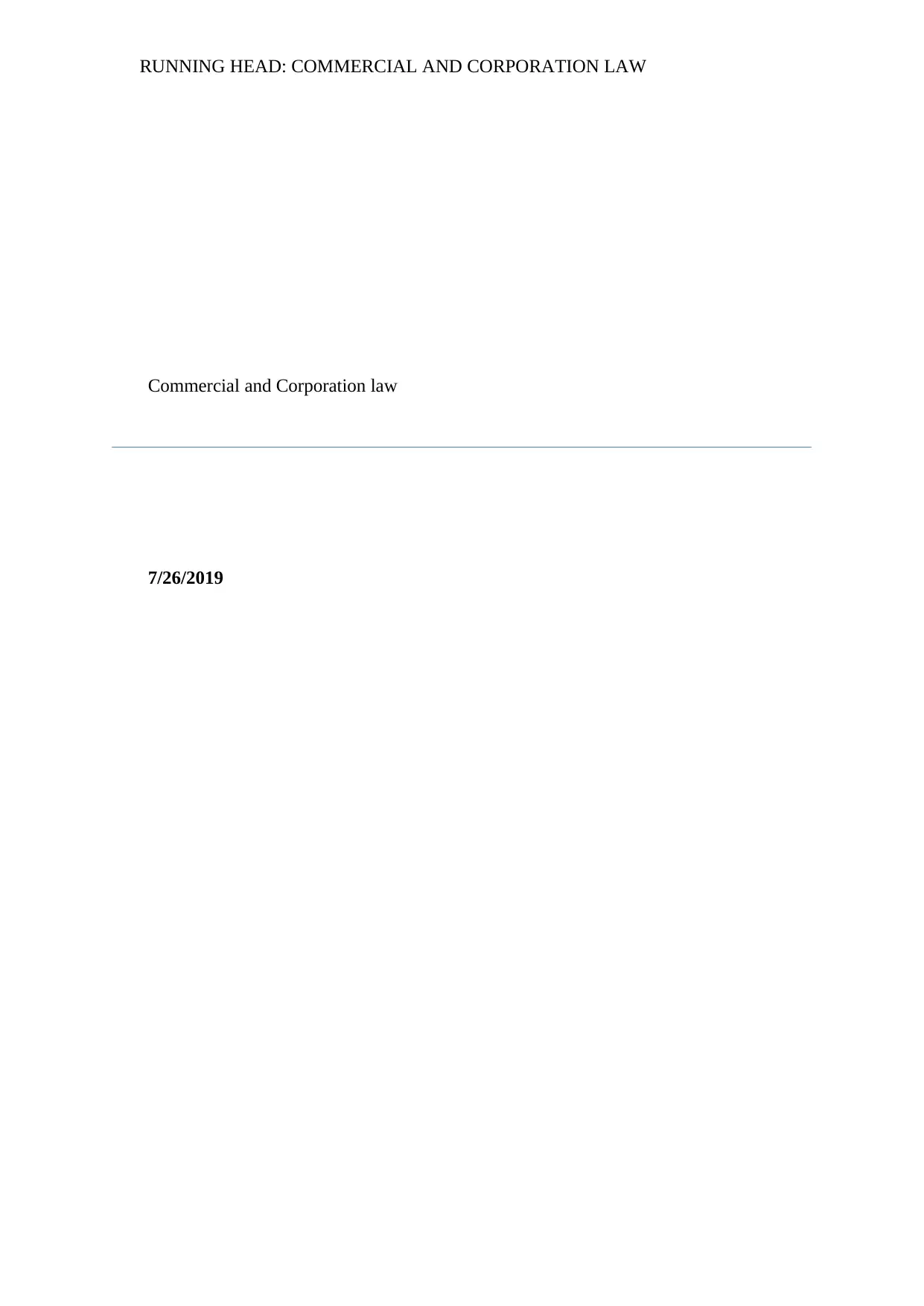
RUNNING HEAD: COMMERCIAL AND CORPORATION LAW
Commercial and Corporation law
7/26/2019
Commercial and Corporation law
7/26/2019
Paraphrase This Document
Need a fresh take? Get an instant paraphrase of this document with our AI Paraphraser
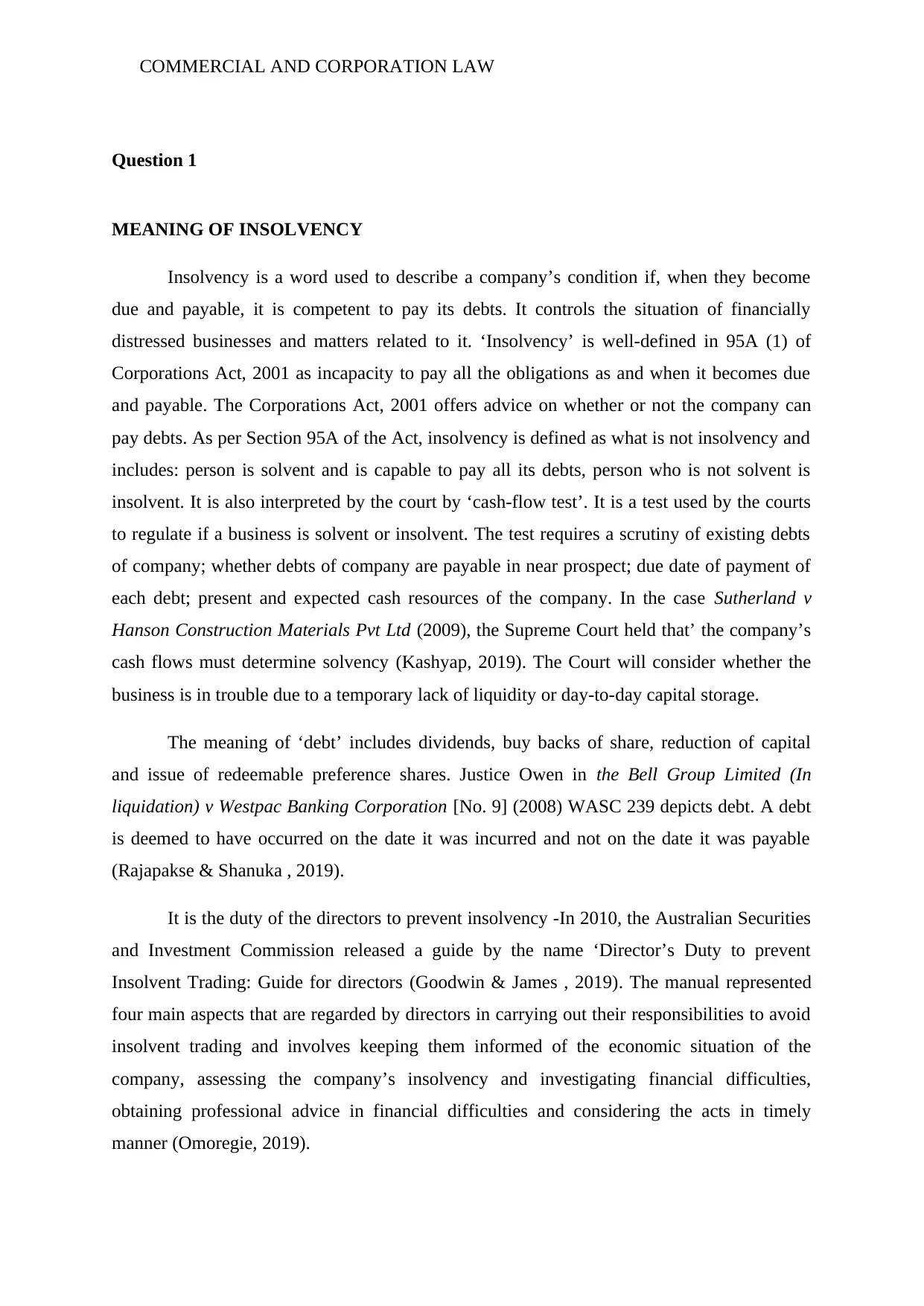
COMMERCIAL AND CORPORATION LAW
Question 1
MEANING OF INSOLVENCY
Insolvency is a word used to describe a company’s condition if, when they become
due and payable, it is competent to pay its debts. It controls the situation of financially
distressed businesses and matters related to it. ‘Insolvency’ is well-defined in 95A (1) of
Corporations Act, 2001 as incapacity to pay all the obligations as and when it becomes due
and payable. The Corporations Act, 2001 offers advice on whether or not the company can
pay debts. As per Section 95A of the Act, insolvency is defined as what is not insolvency and
includes: person is solvent and is capable to pay all its debts, person who is not solvent is
insolvent. It is also interpreted by the court by ‘cash-flow test’. It is a test used by the courts
to regulate if a business is solvent or insolvent. The test requires a scrutiny of existing debts
of company; whether debts of company are payable in near prospect; due date of payment of
each debt; present and expected cash resources of the company. In the case Sutherland v
Hanson Construction Materials Pvt Ltd (2009), the Supreme Court held that’ the company’s
cash flows must determine solvency (Kashyap, 2019). The Court will consider whether the
business is in trouble due to a temporary lack of liquidity or day-to-day capital storage.
The meaning of ‘debt’ includes dividends, buy backs of share, reduction of capital
and issue of redeemable preference shares. Justice Owen in the Bell Group Limited (In
liquidation) v Westpac Banking Corporation [No. 9] (2008) WASC 239 depicts debt. A debt
is deemed to have occurred on the date it was incurred and not on the date it was payable
(Rajapakse & Shanuka , 2019).
It is the duty of the directors to prevent insolvency -In 2010, the Australian Securities
and Investment Commission released a guide by the name ‘Director’s Duty to prevent
Insolvent Trading: Guide for directors (Goodwin & James , 2019). The manual represented
four main aspects that are regarded by directors in carrying out their responsibilities to avoid
insolvent trading and involves keeping them informed of the economic situation of the
company, assessing the company’s insolvency and investigating financial difficulties,
obtaining professional advice in financial difficulties and considering the acts in timely
manner (Omoregie, 2019).
Question 1
MEANING OF INSOLVENCY
Insolvency is a word used to describe a company’s condition if, when they become
due and payable, it is competent to pay its debts. It controls the situation of financially
distressed businesses and matters related to it. ‘Insolvency’ is well-defined in 95A (1) of
Corporations Act, 2001 as incapacity to pay all the obligations as and when it becomes due
and payable. The Corporations Act, 2001 offers advice on whether or not the company can
pay debts. As per Section 95A of the Act, insolvency is defined as what is not insolvency and
includes: person is solvent and is capable to pay all its debts, person who is not solvent is
insolvent. It is also interpreted by the court by ‘cash-flow test’. It is a test used by the courts
to regulate if a business is solvent or insolvent. The test requires a scrutiny of existing debts
of company; whether debts of company are payable in near prospect; due date of payment of
each debt; present and expected cash resources of the company. In the case Sutherland v
Hanson Construction Materials Pvt Ltd (2009), the Supreme Court held that’ the company’s
cash flows must determine solvency (Kashyap, 2019). The Court will consider whether the
business is in trouble due to a temporary lack of liquidity or day-to-day capital storage.
The meaning of ‘debt’ includes dividends, buy backs of share, reduction of capital
and issue of redeemable preference shares. Justice Owen in the Bell Group Limited (In
liquidation) v Westpac Banking Corporation [No. 9] (2008) WASC 239 depicts debt. A debt
is deemed to have occurred on the date it was incurred and not on the date it was payable
(Rajapakse & Shanuka , 2019).
It is the duty of the directors to prevent insolvency -In 2010, the Australian Securities
and Investment Commission released a guide by the name ‘Director’s Duty to prevent
Insolvent Trading: Guide for directors (Goodwin & James , 2019). The manual represented
four main aspects that are regarded by directors in carrying out their responsibilities to avoid
insolvent trading and involves keeping them informed of the economic situation of the
company, assessing the company’s insolvency and investigating financial difficulties,
obtaining professional advice in financial difficulties and considering the acts in timely
manner (Omoregie, 2019).
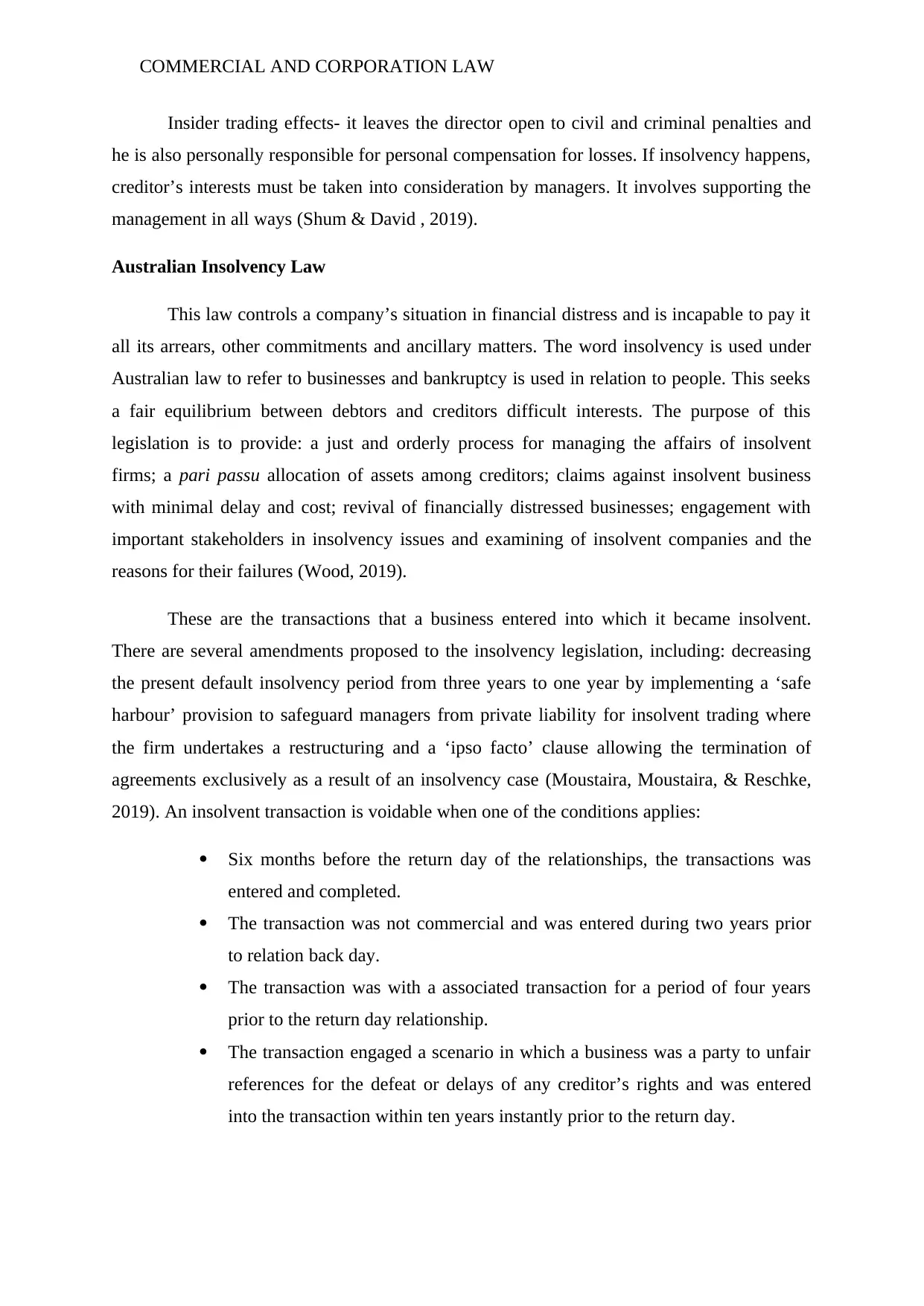
COMMERCIAL AND CORPORATION LAW
Insider trading effects- it leaves the director open to civil and criminal penalties and
he is also personally responsible for personal compensation for losses. If insolvency happens,
creditor’s interests must be taken into consideration by managers. It involves supporting the
management in all ways (Shum & David , 2019).
Australian Insolvency Law
This law controls a company’s situation in financial distress and is incapable to pay it
all its arrears, other commitments and ancillary matters. The word insolvency is used under
Australian law to refer to businesses and bankruptcy is used in relation to people. This seeks
a fair equilibrium between debtors and creditors difficult interests. The purpose of this
legislation is to provide: a just and orderly process for managing the affairs of insolvent
firms; a pari passu allocation of assets among creditors; claims against insolvent business
with minimal delay and cost; revival of financially distressed businesses; engagement with
important stakeholders in insolvency issues and examining of insolvent companies and the
reasons for their failures (Wood, 2019).
These are the transactions that a business entered into which it became insolvent.
There are several amendments proposed to the insolvency legislation, including: decreasing
the present default insolvency period from three years to one year by implementing a ‘safe
harbour’ provision to safeguard managers from private liability for insolvent trading where
the firm undertakes a restructuring and a ‘ipso facto’ clause allowing the termination of
agreements exclusively as a result of an insolvency case (Moustaira, Moustaira, & Reschke,
2019). An insolvent transaction is voidable when one of the conditions applies:
Six months before the return day of the relationships, the transactions was
entered and completed.
The transaction was not commercial and was entered during two years prior
to relation back day.
The transaction was with a associated transaction for a period of four years
prior to the return day relationship.
The transaction engaged a scenario in which a business was a party to unfair
references for the defeat or delays of any creditor’s rights and was entered
into the transaction within ten years instantly prior to the return day.
Insider trading effects- it leaves the director open to civil and criminal penalties and
he is also personally responsible for personal compensation for losses. If insolvency happens,
creditor’s interests must be taken into consideration by managers. It involves supporting the
management in all ways (Shum & David , 2019).
Australian Insolvency Law
This law controls a company’s situation in financial distress and is incapable to pay it
all its arrears, other commitments and ancillary matters. The word insolvency is used under
Australian law to refer to businesses and bankruptcy is used in relation to people. This seeks
a fair equilibrium between debtors and creditors difficult interests. The purpose of this
legislation is to provide: a just and orderly process for managing the affairs of insolvent
firms; a pari passu allocation of assets among creditors; claims against insolvent business
with minimal delay and cost; revival of financially distressed businesses; engagement with
important stakeholders in insolvency issues and examining of insolvent companies and the
reasons for their failures (Wood, 2019).
These are the transactions that a business entered into which it became insolvent.
There are several amendments proposed to the insolvency legislation, including: decreasing
the present default insolvency period from three years to one year by implementing a ‘safe
harbour’ provision to safeguard managers from private liability for insolvent trading where
the firm undertakes a restructuring and a ‘ipso facto’ clause allowing the termination of
agreements exclusively as a result of an insolvency case (Moustaira, Moustaira, & Reschke,
2019). An insolvent transaction is voidable when one of the conditions applies:
Six months before the return day of the relationships, the transactions was
entered and completed.
The transaction was not commercial and was entered during two years prior
to relation back day.
The transaction was with a associated transaction for a period of four years
prior to the return day relationship.
The transaction engaged a scenario in which a business was a party to unfair
references for the defeat or delays of any creditor’s rights and was entered
into the transaction within ten years instantly prior to the return day.
⊘ This is a preview!⊘
Do you want full access?
Subscribe today to unlock all pages.

Trusted by 1+ million students worldwide
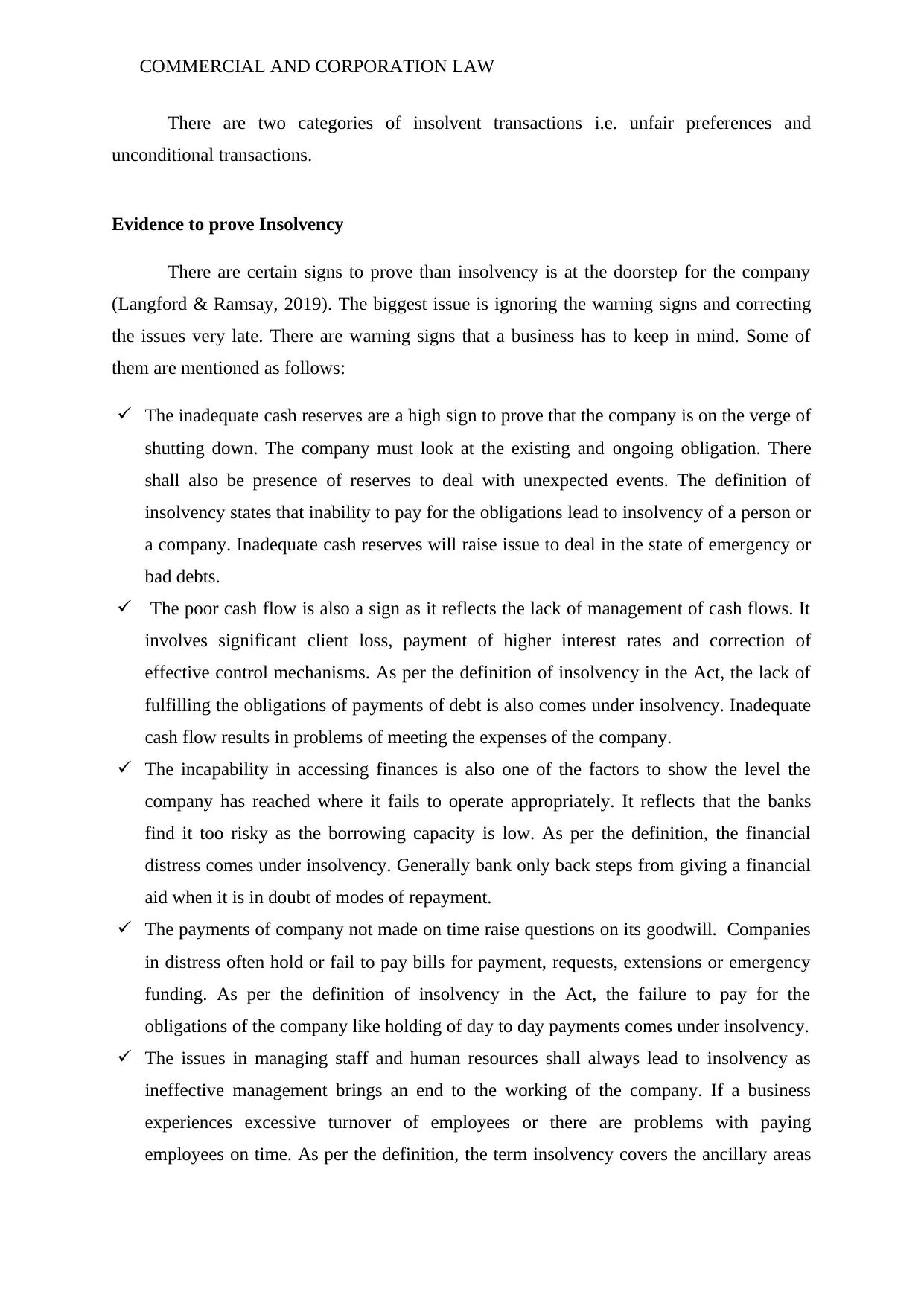
COMMERCIAL AND CORPORATION LAW
There are two categories of insolvent transactions i.e. unfair preferences and
unconditional transactions.
Evidence to prove Insolvency
There are certain signs to prove than insolvency is at the doorstep for the company
(Langford & Ramsay, 2019). The biggest issue is ignoring the warning signs and correcting
the issues very late. There are warning signs that a business has to keep in mind. Some of
them are mentioned as follows:
The inadequate cash reserves are a high sign to prove that the company is on the verge of
shutting down. The company must look at the existing and ongoing obligation. There
shall also be presence of reserves to deal with unexpected events. The definition of
insolvency states that inability to pay for the obligations lead to insolvency of a person or
a company. Inadequate cash reserves will raise issue to deal in the state of emergency or
bad debts.
The poor cash flow is also a sign as it reflects the lack of management of cash flows. It
involves significant client loss, payment of higher interest rates and correction of
effective control mechanisms. As per the definition of insolvency in the Act, the lack of
fulfilling the obligations of payments of debt is also comes under insolvency. Inadequate
cash flow results in problems of meeting the expenses of the company.
The incapability in accessing finances is also one of the factors to show the level the
company has reached where it fails to operate appropriately. It reflects that the banks
find it too risky as the borrowing capacity is low. As per the definition, the financial
distress comes under insolvency. Generally bank only back steps from giving a financial
aid when it is in doubt of modes of repayment.
The payments of company not made on time raise questions on its goodwill. Companies
in distress often hold or fail to pay bills for payment, requests, extensions or emergency
funding. As per the definition of insolvency in the Act, the failure to pay for the
obligations of the company like holding of day to day payments comes under insolvency.
The issues in managing staff and human resources shall always lead to insolvency as
ineffective management brings an end to the working of the company. If a business
experiences excessive turnover of employees or there are problems with paying
employees on time. As per the definition, the term insolvency covers the ancillary areas
There are two categories of insolvent transactions i.e. unfair preferences and
unconditional transactions.
Evidence to prove Insolvency
There are certain signs to prove than insolvency is at the doorstep for the company
(Langford & Ramsay, 2019). The biggest issue is ignoring the warning signs and correcting
the issues very late. There are warning signs that a business has to keep in mind. Some of
them are mentioned as follows:
The inadequate cash reserves are a high sign to prove that the company is on the verge of
shutting down. The company must look at the existing and ongoing obligation. There
shall also be presence of reserves to deal with unexpected events. The definition of
insolvency states that inability to pay for the obligations lead to insolvency of a person or
a company. Inadequate cash reserves will raise issue to deal in the state of emergency or
bad debts.
The poor cash flow is also a sign as it reflects the lack of management of cash flows. It
involves significant client loss, payment of higher interest rates and correction of
effective control mechanisms. As per the definition of insolvency in the Act, the lack of
fulfilling the obligations of payments of debt is also comes under insolvency. Inadequate
cash flow results in problems of meeting the expenses of the company.
The incapability in accessing finances is also one of the factors to show the level the
company has reached where it fails to operate appropriately. It reflects that the banks
find it too risky as the borrowing capacity is low. As per the definition, the financial
distress comes under insolvency. Generally bank only back steps from giving a financial
aid when it is in doubt of modes of repayment.
The payments of company not made on time raise questions on its goodwill. Companies
in distress often hold or fail to pay bills for payment, requests, extensions or emergency
funding. As per the definition of insolvency in the Act, the failure to pay for the
obligations of the company like holding of day to day payments comes under insolvency.
The issues in managing staff and human resources shall always lead to insolvency as
ineffective management brings an end to the working of the company. If a business
experiences excessive turnover of employees or there are problems with paying
employees on time. As per the definition, the term insolvency covers the ancillary areas
Paraphrase This Document
Need a fresh take? Get an instant paraphrase of this document with our AI Paraphraser
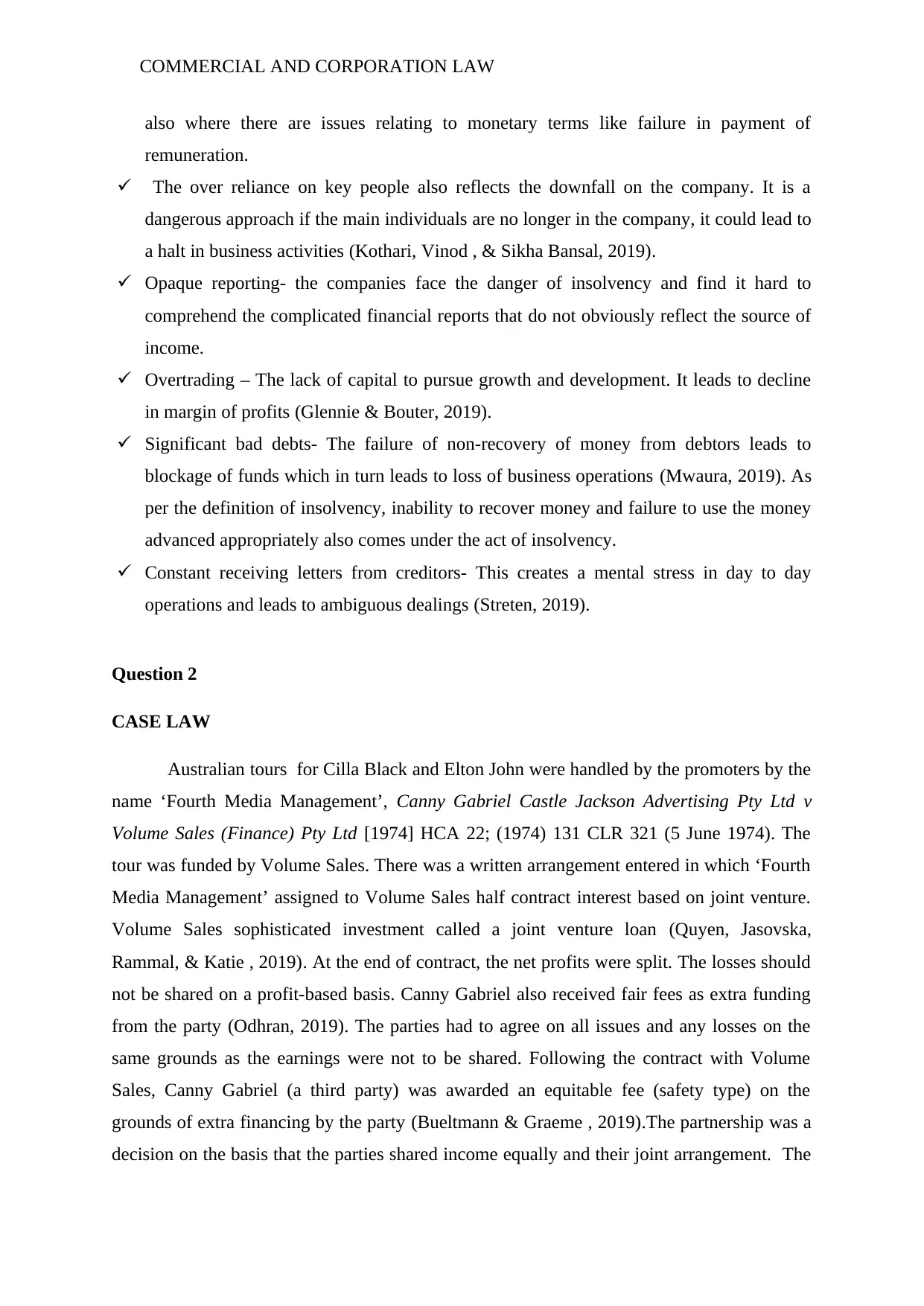
COMMERCIAL AND CORPORATION LAW
also where there are issues relating to monetary terms like failure in payment of
remuneration.
The over reliance on key people also reflects the downfall on the company. It is a
dangerous approach if the main individuals are no longer in the company, it could lead to
a halt in business activities (Kothari, Vinod , & Sikha Bansal, 2019).
Opaque reporting- the companies face the danger of insolvency and find it hard to
comprehend the complicated financial reports that do not obviously reflect the source of
income.
Overtrading – The lack of capital to pursue growth and development. It leads to decline
in margin of profits (Glennie & Bouter, 2019).
Significant bad debts- The failure of non-recovery of money from debtors leads to
blockage of funds which in turn leads to loss of business operations (Mwaura, 2019). As
per the definition of insolvency, inability to recover money and failure to use the money
advanced appropriately also comes under the act of insolvency.
Constant receiving letters from creditors- This creates a mental stress in day to day
operations and leads to ambiguous dealings (Streten, 2019).
Question 2
CASE LAW
Australian tours for Cilla Black and Elton John were handled by the promoters by the
name ‘Fourth Media Management’, Canny Gabriel Castle Jackson Advertising Pty Ltd v
Volume Sales (Finance) Pty Ltd [1974] HCA 22; (1974) 131 CLR 321 (5 June 1974). The
tour was funded by Volume Sales. There was a written arrangement entered in which ‘Fourth
Media Management’ assigned to Volume Sales half contract interest based on joint venture.
Volume Sales sophisticated investment called a joint venture loan (Quyen, Jasovska,
Rammal, & Katie , 2019). At the end of contract, the net profits were split. The losses should
not be shared on a profit-based basis. Canny Gabriel also received fair fees as extra funding
from the party (Odhran, 2019). The parties had to agree on all issues and any losses on the
same grounds as the earnings were not to be shared. Following the contract with Volume
Sales, Canny Gabriel (a third party) was awarded an equitable fee (safety type) on the
grounds of extra financing by the party (Bueltmann & Graeme , 2019).The partnership was a
decision on the basis that the parties shared income equally and their joint arrangement. The
also where there are issues relating to monetary terms like failure in payment of
remuneration.
The over reliance on key people also reflects the downfall on the company. It is a
dangerous approach if the main individuals are no longer in the company, it could lead to
a halt in business activities (Kothari, Vinod , & Sikha Bansal, 2019).
Opaque reporting- the companies face the danger of insolvency and find it hard to
comprehend the complicated financial reports that do not obviously reflect the source of
income.
Overtrading – The lack of capital to pursue growth and development. It leads to decline
in margin of profits (Glennie & Bouter, 2019).
Significant bad debts- The failure of non-recovery of money from debtors leads to
blockage of funds which in turn leads to loss of business operations (Mwaura, 2019). As
per the definition of insolvency, inability to recover money and failure to use the money
advanced appropriately also comes under the act of insolvency.
Constant receiving letters from creditors- This creates a mental stress in day to day
operations and leads to ambiguous dealings (Streten, 2019).
Question 2
CASE LAW
Australian tours for Cilla Black and Elton John were handled by the promoters by the
name ‘Fourth Media Management’, Canny Gabriel Castle Jackson Advertising Pty Ltd v
Volume Sales (Finance) Pty Ltd [1974] HCA 22; (1974) 131 CLR 321 (5 June 1974). The
tour was funded by Volume Sales. There was a written arrangement entered in which ‘Fourth
Media Management’ assigned to Volume Sales half contract interest based on joint venture.
Volume Sales sophisticated investment called a joint venture loan (Quyen, Jasovska,
Rammal, & Katie , 2019). At the end of contract, the net profits were split. The losses should
not be shared on a profit-based basis. Canny Gabriel also received fair fees as extra funding
from the party (Odhran, 2019). The parties had to agree on all issues and any losses on the
same grounds as the earnings were not to be shared. Following the contract with Volume
Sales, Canny Gabriel (a third party) was awarded an equitable fee (safety type) on the
grounds of extra financing by the party (Bueltmann & Graeme , 2019).The partnership was a
decision on the basis that the parties shared income equally and their joint arrangement. The
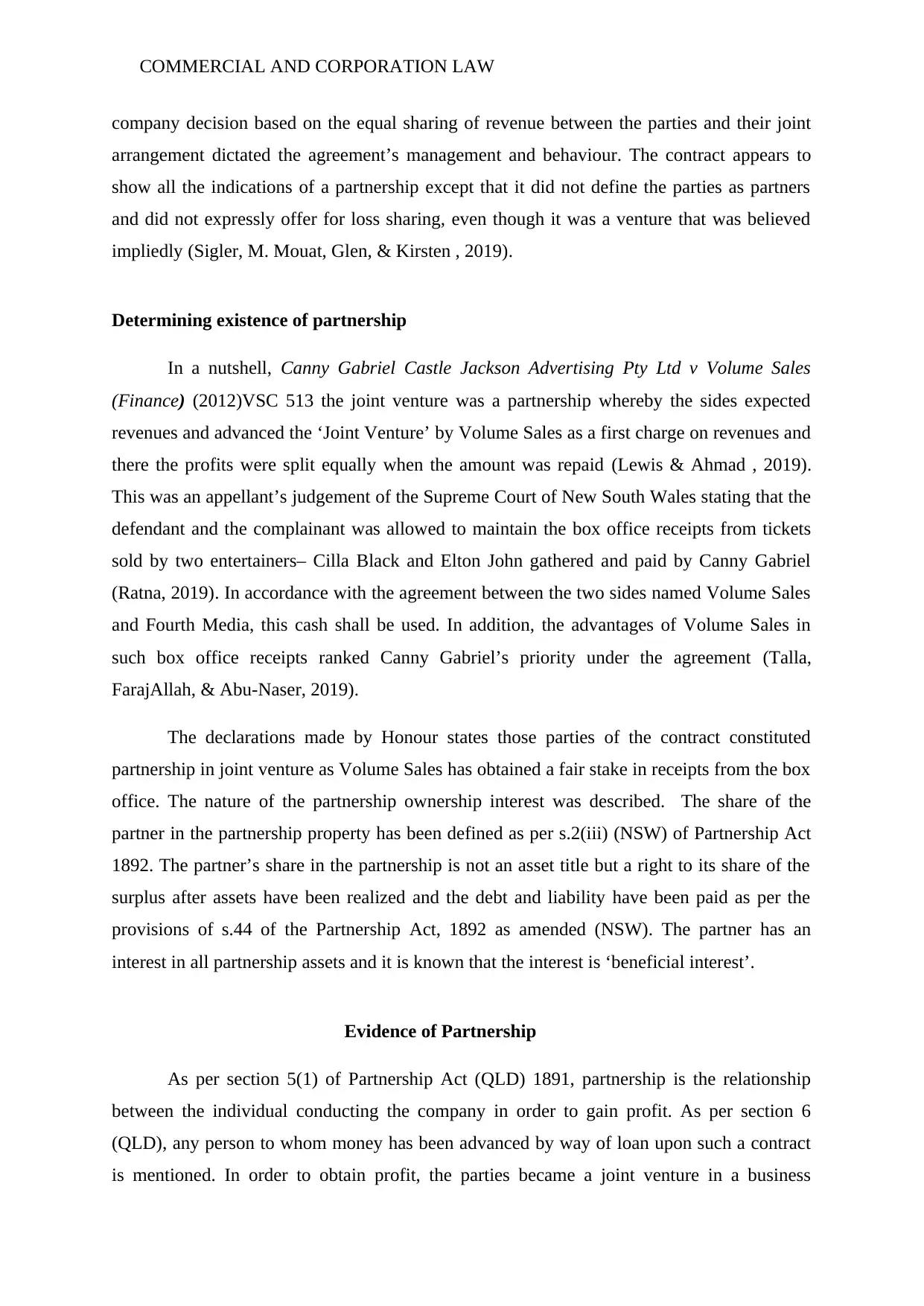
COMMERCIAL AND CORPORATION LAW
company decision based on the equal sharing of revenue between the parties and their joint
arrangement dictated the agreement’s management and behaviour. The contract appears to
show all the indications of a partnership except that it did not define the parties as partners
and did not expressly offer for loss sharing, even though it was a venture that was believed
impliedly (Sigler, M. Mouat, Glen, & Kirsten , 2019).
Determining existence of partnership
In a nutshell, Canny Gabriel Castle Jackson Advertising Pty Ltd v Volume Sales
(Finance) (2012)VSC 513 the joint venture was a partnership whereby the sides expected
revenues and advanced the ‘Joint Venture’ by Volume Sales as a first charge on revenues and
there the profits were split equally when the amount was repaid (Lewis & Ahmad , 2019).
This was an appellant’s judgement of the Supreme Court of New South Wales stating that the
defendant and the complainant was allowed to maintain the box office receipts from tickets
sold by two entertainers– Cilla Black and Elton John gathered and paid by Canny Gabriel
(Ratna, 2019). In accordance with the agreement between the two sides named Volume Sales
and Fourth Media, this cash shall be used. In addition, the advantages of Volume Sales in
such box office receipts ranked Canny Gabriel’s priority under the agreement (Talla,
FarajAllah, & Abu-Naser, 2019).
The declarations made by Honour states those parties of the contract constituted
partnership in joint venture as Volume Sales has obtained a fair stake in receipts from the box
office. The nature of the partnership ownership interest was described. The share of the
partner in the partnership property has been defined as per s.2(iii) (NSW) of Partnership Act
1892. The partner’s share in the partnership is not an asset title but a right to its share of the
surplus after assets have been realized and the debt and liability have been paid as per the
provisions of s.44 of the Partnership Act, 1892 as amended (NSW). The partner has an
interest in all partnership assets and it is known that the interest is ‘beneficial interest’.
Evidence of Partnership
As per section 5(1) of Partnership Act (QLD) 1891, partnership is the relationship
between the individual conducting the company in order to gain profit. As per section 6
(QLD), any person to whom money has been advanced by way of loan upon such a contract
is mentioned. In order to obtain profit, the parties became a joint venture in a business
company decision based on the equal sharing of revenue between the parties and their joint
arrangement dictated the agreement’s management and behaviour. The contract appears to
show all the indications of a partnership except that it did not define the parties as partners
and did not expressly offer for loss sharing, even though it was a venture that was believed
impliedly (Sigler, M. Mouat, Glen, & Kirsten , 2019).
Determining existence of partnership
In a nutshell, Canny Gabriel Castle Jackson Advertising Pty Ltd v Volume Sales
(Finance) (2012)VSC 513 the joint venture was a partnership whereby the sides expected
revenues and advanced the ‘Joint Venture’ by Volume Sales as a first charge on revenues and
there the profits were split equally when the amount was repaid (Lewis & Ahmad , 2019).
This was an appellant’s judgement of the Supreme Court of New South Wales stating that the
defendant and the complainant was allowed to maintain the box office receipts from tickets
sold by two entertainers– Cilla Black and Elton John gathered and paid by Canny Gabriel
(Ratna, 2019). In accordance with the agreement between the two sides named Volume Sales
and Fourth Media, this cash shall be used. In addition, the advantages of Volume Sales in
such box office receipts ranked Canny Gabriel’s priority under the agreement (Talla,
FarajAllah, & Abu-Naser, 2019).
The declarations made by Honour states those parties of the contract constituted
partnership in joint venture as Volume Sales has obtained a fair stake in receipts from the box
office. The nature of the partnership ownership interest was described. The share of the
partner in the partnership property has been defined as per s.2(iii) (NSW) of Partnership Act
1892. The partner’s share in the partnership is not an asset title but a right to its share of the
surplus after assets have been realized and the debt and liability have been paid as per the
provisions of s.44 of the Partnership Act, 1892 as amended (NSW). The partner has an
interest in all partnership assets and it is known that the interest is ‘beneficial interest’.
Evidence of Partnership
As per section 5(1) of Partnership Act (QLD) 1891, partnership is the relationship
between the individual conducting the company in order to gain profit. As per section 6
(QLD), any person to whom money has been advanced by way of loan upon such a contract
is mentioned. In order to obtain profit, the parties became a joint venture in a business
⊘ This is a preview!⊘
Do you want full access?
Subscribe today to unlock all pages.

Trusted by 1+ million students worldwide
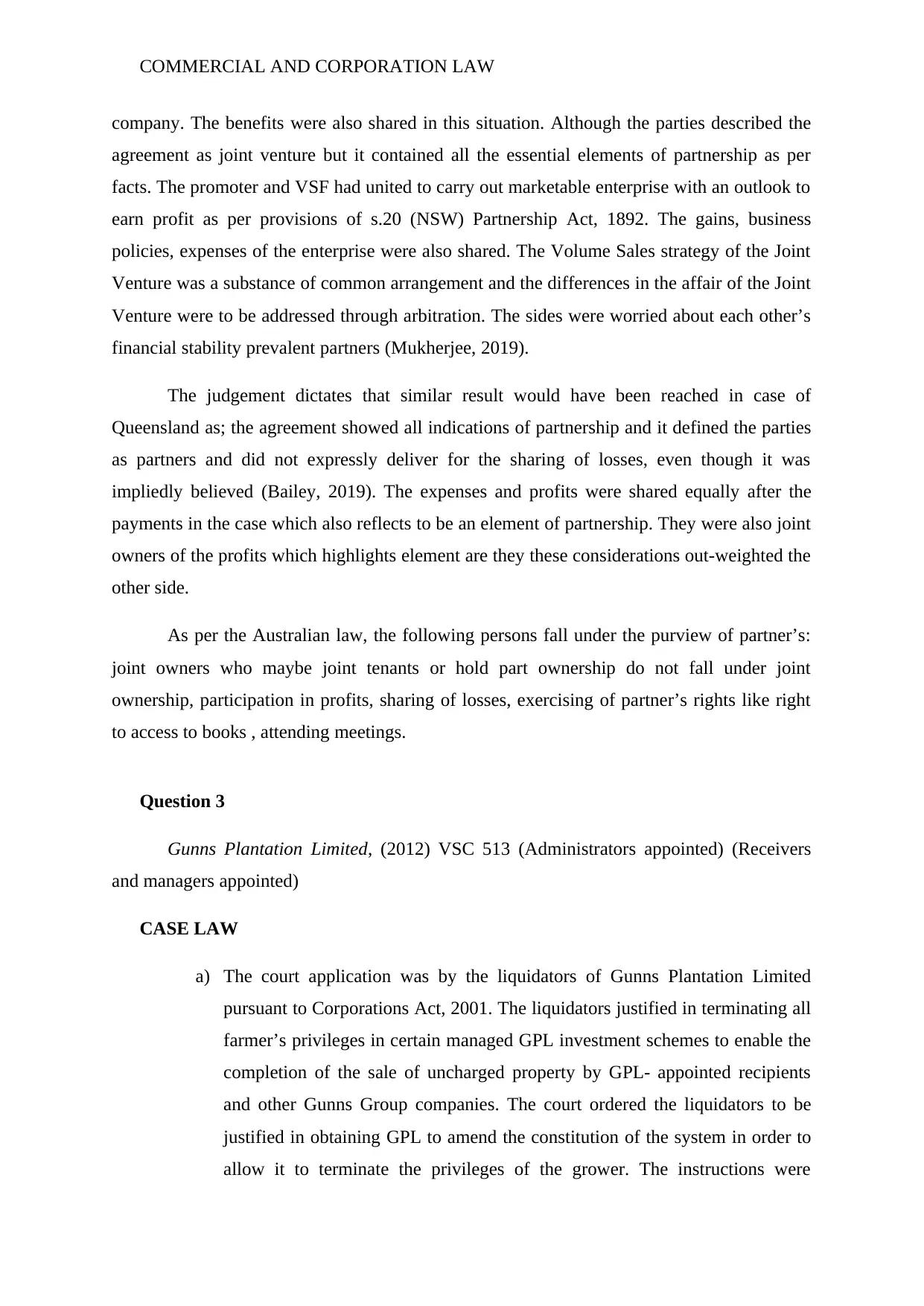
COMMERCIAL AND CORPORATION LAW
company. The benefits were also shared in this situation. Although the parties described the
agreement as joint venture but it contained all the essential elements of partnership as per
facts. The promoter and VSF had united to carry out marketable enterprise with an outlook to
earn profit as per provisions of s.20 (NSW) Partnership Act, 1892. The gains, business
policies, expenses of the enterprise were also shared. The Volume Sales strategy of the Joint
Venture was a substance of common arrangement and the differences in the affair of the Joint
Venture were to be addressed through arbitration. The sides were worried about each other’s
financial stability prevalent partners (Mukherjee, 2019).
The judgement dictates that similar result would have been reached in case of
Queensland as; the agreement showed all indications of partnership and it defined the parties
as partners and did not expressly deliver for the sharing of losses, even though it was
impliedly believed (Bailey, 2019). The expenses and profits were shared equally after the
payments in the case which also reflects to be an element of partnership. They were also joint
owners of the profits which highlights element are they these considerations out-weighted the
other side.
As per the Australian law, the following persons fall under the purview of partner’s:
joint owners who maybe joint tenants or hold part ownership do not fall under joint
ownership, participation in profits, sharing of losses, exercising of partner’s rights like right
to access to books , attending meetings.
Question 3
Gunns Plantation Limited, (2012) VSC 513 (Administrators appointed) (Receivers
and managers appointed)
CASE LAW
a) The court application was by the liquidators of Gunns Plantation Limited
pursuant to Corporations Act, 2001. The liquidators justified in terminating all
farmer’s privileges in certain managed GPL investment schemes to enable the
completion of the sale of uncharged property by GPL- appointed recipients
and other Gunns Group companies. The court ordered the liquidators to be
justified in obtaining GPL to amend the constitution of the system in order to
allow it to terminate the privileges of the grower. The instructions were
company. The benefits were also shared in this situation. Although the parties described the
agreement as joint venture but it contained all the essential elements of partnership as per
facts. The promoter and VSF had united to carry out marketable enterprise with an outlook to
earn profit as per provisions of s.20 (NSW) Partnership Act, 1892. The gains, business
policies, expenses of the enterprise were also shared. The Volume Sales strategy of the Joint
Venture was a substance of common arrangement and the differences in the affair of the Joint
Venture were to be addressed through arbitration. The sides were worried about each other’s
financial stability prevalent partners (Mukherjee, 2019).
The judgement dictates that similar result would have been reached in case of
Queensland as; the agreement showed all indications of partnership and it defined the parties
as partners and did not expressly deliver for the sharing of losses, even though it was
impliedly believed (Bailey, 2019). The expenses and profits were shared equally after the
payments in the case which also reflects to be an element of partnership. They were also joint
owners of the profits which highlights element are they these considerations out-weighted the
other side.
As per the Australian law, the following persons fall under the purview of partner’s:
joint owners who maybe joint tenants or hold part ownership do not fall under joint
ownership, participation in profits, sharing of losses, exercising of partner’s rights like right
to access to books , attending meetings.
Question 3
Gunns Plantation Limited, (2012) VSC 513 (Administrators appointed) (Receivers
and managers appointed)
CASE LAW
a) The court application was by the liquidators of Gunns Plantation Limited
pursuant to Corporations Act, 2001. The liquidators justified in terminating all
farmer’s privileges in certain managed GPL investment schemes to enable the
completion of the sale of uncharged property by GPL- appointed recipients
and other Gunns Group companies. The court ordered the liquidators to be
justified in obtaining GPL to amend the constitution of the system in order to
allow it to terminate the privileges of the grower. The instructions were
Paraphrase This Document
Need a fresh take? Get an instant paraphrase of this document with our AI Paraphraser
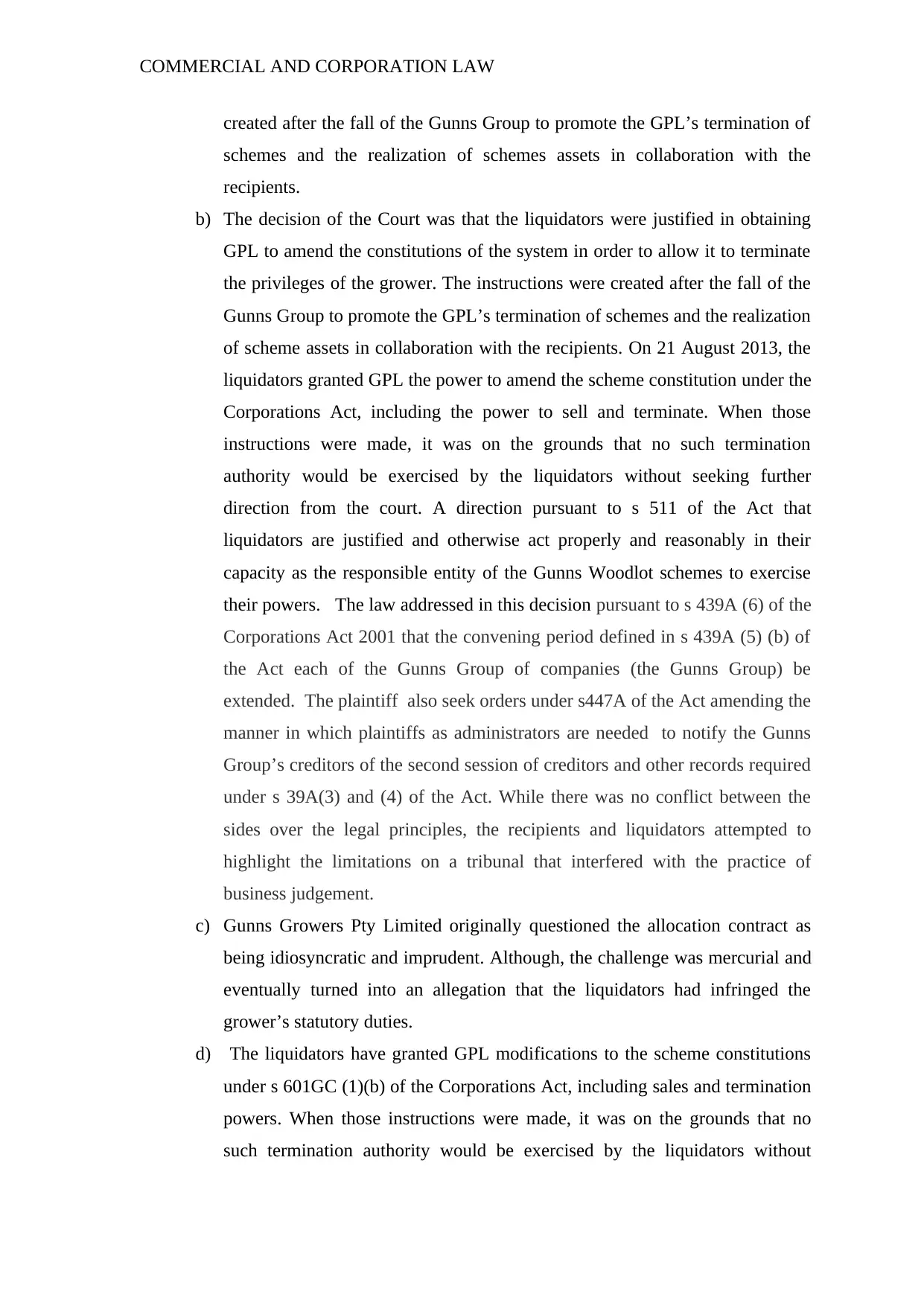
COMMERCIAL AND CORPORATION LAW
created after the fall of the Gunns Group to promote the GPL’s termination of
schemes and the realization of schemes assets in collaboration with the
recipients.
b) The decision of the Court was that the liquidators were justified in obtaining
GPL to amend the constitutions of the system in order to allow it to terminate
the privileges of the grower. The instructions were created after the fall of the
Gunns Group to promote the GPL’s termination of schemes and the realization
of scheme assets in collaboration with the recipients. On 21 August 2013, the
liquidators granted GPL the power to amend the scheme constitution under the
Corporations Act, including the power to sell and terminate. When those
instructions were made, it was on the grounds that no such termination
authority would be exercised by the liquidators without seeking further
direction from the court. A direction pursuant to s 511 of the Act that
liquidators are justified and otherwise act properly and reasonably in their
capacity as the responsible entity of the Gunns Woodlot schemes to exercise
their powers. The law addressed in this decision pursuant to s 439A (6) of the
Corporations Act 2001 that the convening period defined in s 439A (5) (b) of
the Act each of the Gunns Group of companies (the Gunns Group) be
extended. The plaintiff also seek orders under s447A of the Act amending the
manner in which plaintiffs as administrators are needed to notify the Gunns
Group’s creditors of the second session of creditors and other records required
under s 39A(3) and (4) of the Act. While there was no conflict between the
sides over the legal principles, the recipients and liquidators attempted to
highlight the limitations on a tribunal that interfered with the practice of
business judgement.
c) Gunns Growers Pty Limited originally questioned the allocation contract as
being idiosyncratic and imprudent. Although, the challenge was mercurial and
eventually turned into an allegation that the liquidators had infringed the
grower’s statutory duties.
d) The liquidators have granted GPL modifications to the scheme constitutions
under s 601GC (1)(b) of the Corporations Act, including sales and termination
powers. When those instructions were made, it was on the grounds that no
such termination authority would be exercised by the liquidators without
created after the fall of the Gunns Group to promote the GPL’s termination of
schemes and the realization of schemes assets in collaboration with the
recipients.
b) The decision of the Court was that the liquidators were justified in obtaining
GPL to amend the constitutions of the system in order to allow it to terminate
the privileges of the grower. The instructions were created after the fall of the
Gunns Group to promote the GPL’s termination of schemes and the realization
of scheme assets in collaboration with the recipients. On 21 August 2013, the
liquidators granted GPL the power to amend the scheme constitution under the
Corporations Act, including the power to sell and terminate. When those
instructions were made, it was on the grounds that no such termination
authority would be exercised by the liquidators without seeking further
direction from the court. A direction pursuant to s 511 of the Act that
liquidators are justified and otherwise act properly and reasonably in their
capacity as the responsible entity of the Gunns Woodlot schemes to exercise
their powers. The law addressed in this decision pursuant to s 439A (6) of the
Corporations Act 2001 that the convening period defined in s 439A (5) (b) of
the Act each of the Gunns Group of companies (the Gunns Group) be
extended. The plaintiff also seek orders under s447A of the Act amending the
manner in which plaintiffs as administrators are needed to notify the Gunns
Group’s creditors of the second session of creditors and other records required
under s 39A(3) and (4) of the Act. While there was no conflict between the
sides over the legal principles, the recipients and liquidators attempted to
highlight the limitations on a tribunal that interfered with the practice of
business judgement.
c) Gunns Growers Pty Limited originally questioned the allocation contract as
being idiosyncratic and imprudent. Although, the challenge was mercurial and
eventually turned into an allegation that the liquidators had infringed the
grower’s statutory duties.
d) The liquidators have granted GPL modifications to the scheme constitutions
under s 601GC (1)(b) of the Corporations Act, including sales and termination
powers. When those instructions were made, it was on the grounds that no
such termination authority would be exercised by the liquidators without
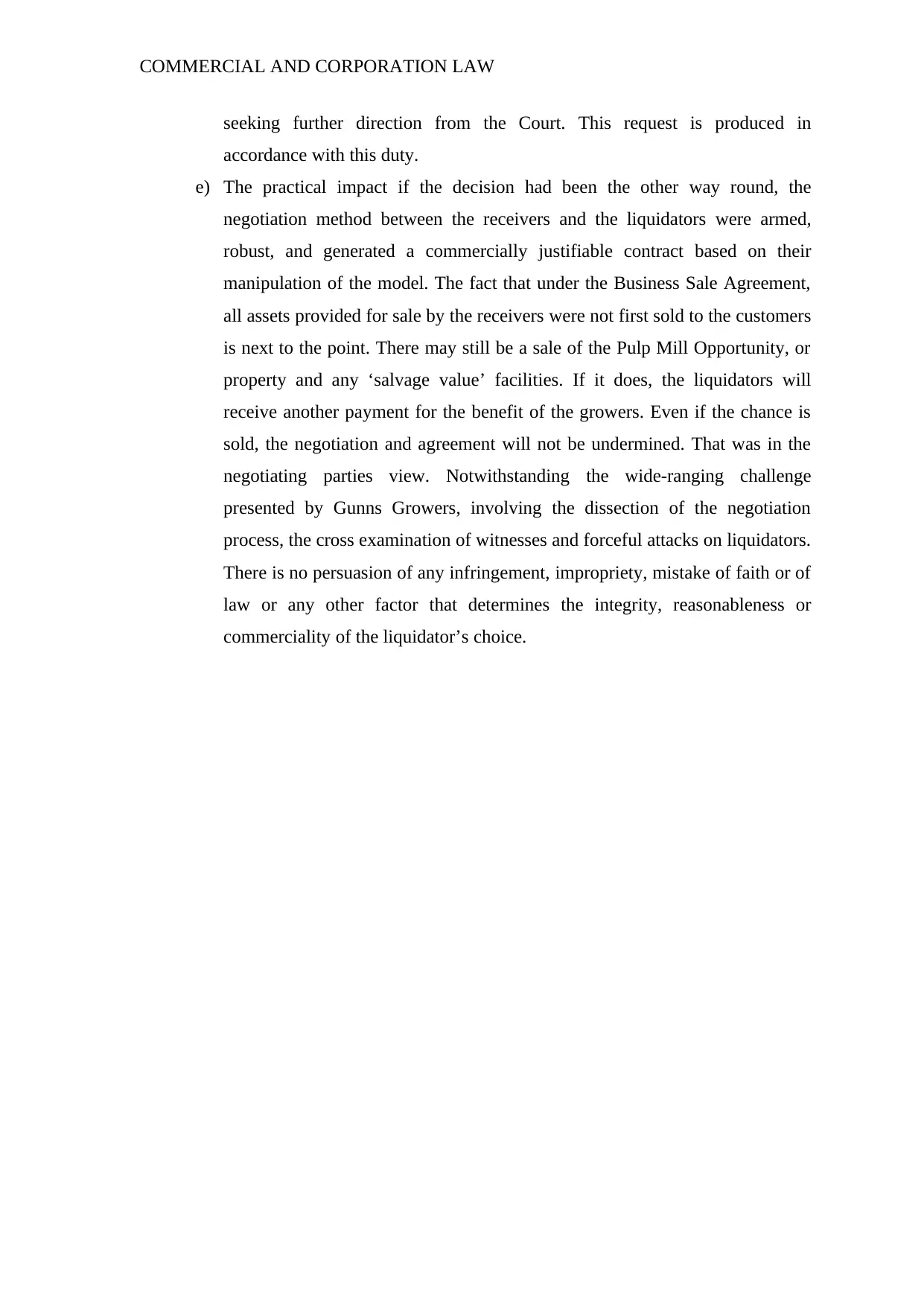
COMMERCIAL AND CORPORATION LAW
seeking further direction from the Court. This request is produced in
accordance with this duty.
e) The practical impact if the decision had been the other way round, the
negotiation method between the receivers and the liquidators were armed,
robust, and generated a commercially justifiable contract based on their
manipulation of the model. The fact that under the Business Sale Agreement,
all assets provided for sale by the receivers were not first sold to the customers
is next to the point. There may still be a sale of the Pulp Mill Opportunity, or
property and any ‘salvage value’ facilities. If it does, the liquidators will
receive another payment for the benefit of the growers. Even if the chance is
sold, the negotiation and agreement will not be undermined. That was in the
negotiating parties view. Notwithstanding the wide-ranging challenge
presented by Gunns Growers, involving the dissection of the negotiation
process, the cross examination of witnesses and forceful attacks on liquidators.
There is no persuasion of any infringement, impropriety, mistake of faith or of
law or any other factor that determines the integrity, reasonableness or
commerciality of the liquidator’s choice.
seeking further direction from the Court. This request is produced in
accordance with this duty.
e) The practical impact if the decision had been the other way round, the
negotiation method between the receivers and the liquidators were armed,
robust, and generated a commercially justifiable contract based on their
manipulation of the model. The fact that under the Business Sale Agreement,
all assets provided for sale by the receivers were not first sold to the customers
is next to the point. There may still be a sale of the Pulp Mill Opportunity, or
property and any ‘salvage value’ facilities. If it does, the liquidators will
receive another payment for the benefit of the growers. Even if the chance is
sold, the negotiation and agreement will not be undermined. That was in the
negotiating parties view. Notwithstanding the wide-ranging challenge
presented by Gunns Growers, involving the dissection of the negotiation
process, the cross examination of witnesses and forceful attacks on liquidators.
There is no persuasion of any infringement, impropriety, mistake of faith or of
law or any other factor that determines the integrity, reasonableness or
commerciality of the liquidator’s choice.
⊘ This is a preview!⊘
Do you want full access?
Subscribe today to unlock all pages.

Trusted by 1+ million students worldwide
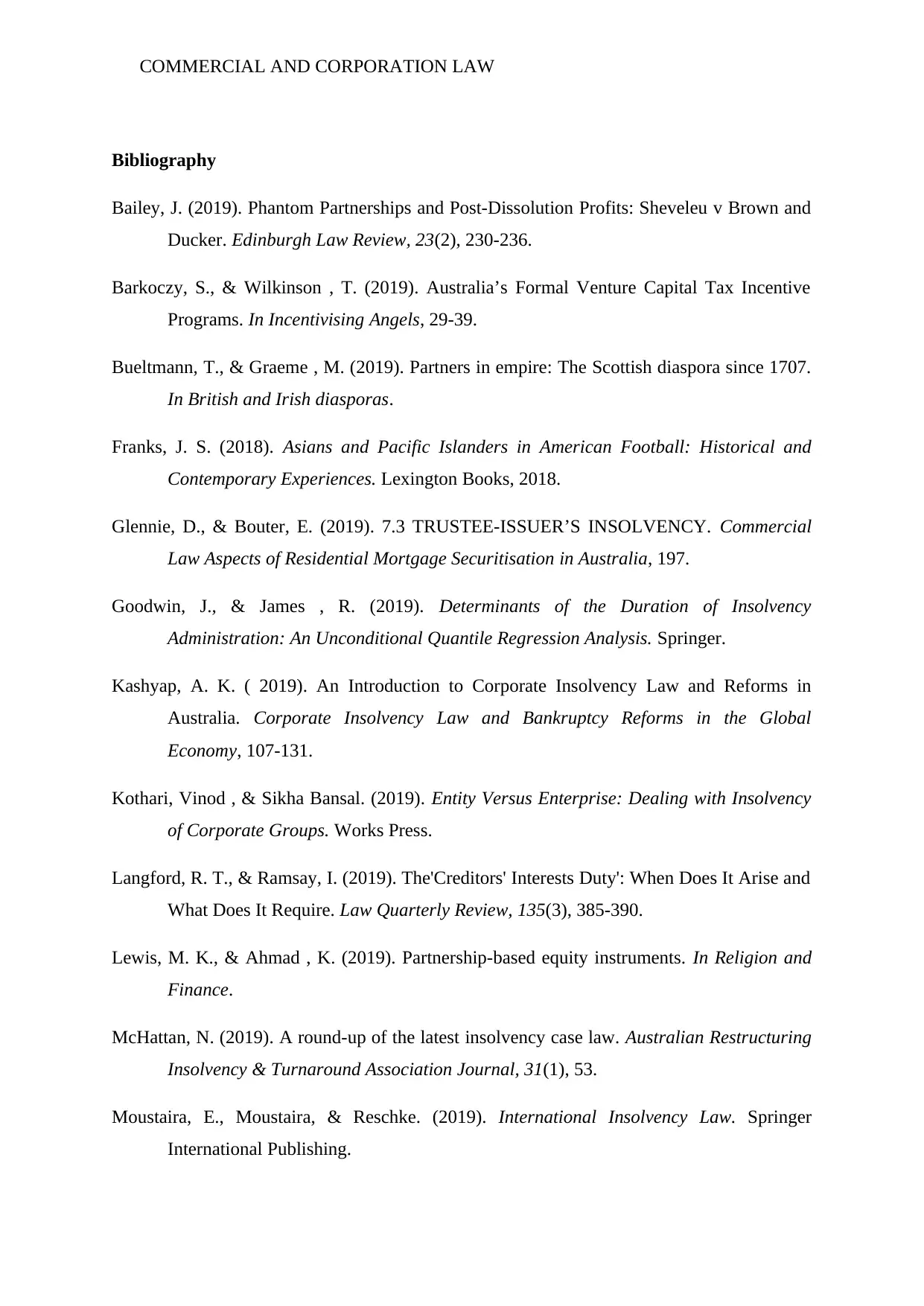
COMMERCIAL AND CORPORATION LAW
Bibliography
Bailey, J. (2019). Phantom Partnerships and Post-Dissolution Profits: Sheveleu v Brown and
Ducker. Edinburgh Law Review, 23(2), 230-236.
Barkoczy, S., & Wilkinson , T. (2019). Australia’s Formal Venture Capital Tax Incentive
Programs. In Incentivising Angels, 29-39.
Bueltmann, T., & Graeme , M. (2019). Partners in empire: The Scottish diaspora since 1707.
In British and Irish diasporas.
Franks, J. S. (2018). Asians and Pacific Islanders in American Football: Historical and
Contemporary Experiences. Lexington Books, 2018.
Glennie, D., & Bouter, E. (2019). 7.3 TRUSTEE-ISSUER’S INSOLVENCY. Commercial
Law Aspects of Residential Mortgage Securitisation in Australia, 197.
Goodwin, J., & James , R. (2019). Determinants of the Duration of Insolvency
Administration: An Unconditional Quantile Regression Analysis. Springer.
Kashyap, A. K. ( 2019). An Introduction to Corporate Insolvency Law and Reforms in
Australia. Corporate Insolvency Law and Bankruptcy Reforms in the Global
Economy, 107-131.
Kothari, Vinod , & Sikha Bansal. (2019). Entity Versus Enterprise: Dealing with Insolvency
of Corporate Groups. Works Press.
Langford, R. T., & Ramsay, I. (2019). The'Creditors' Interests Duty': When Does It Arise and
What Does It Require. Law Quarterly Review, 135(3), 385-390.
Lewis, M. K., & Ahmad , K. (2019). Partnership-based equity instruments. In Religion and
Finance.
McHattan, N. (2019). A round-up of the latest insolvency case law. Australian Restructuring
Insolvency & Turnaround Association Journal, 31(1), 53.
Moustaira, E., Moustaira, & Reschke. (2019). International Insolvency Law. Springer
International Publishing.
Bibliography
Bailey, J. (2019). Phantom Partnerships and Post-Dissolution Profits: Sheveleu v Brown and
Ducker. Edinburgh Law Review, 23(2), 230-236.
Barkoczy, S., & Wilkinson , T. (2019). Australia’s Formal Venture Capital Tax Incentive
Programs. In Incentivising Angels, 29-39.
Bueltmann, T., & Graeme , M. (2019). Partners in empire: The Scottish diaspora since 1707.
In British and Irish diasporas.
Franks, J. S. (2018). Asians and Pacific Islanders in American Football: Historical and
Contemporary Experiences. Lexington Books, 2018.
Glennie, D., & Bouter, E. (2019). 7.3 TRUSTEE-ISSUER’S INSOLVENCY. Commercial
Law Aspects of Residential Mortgage Securitisation in Australia, 197.
Goodwin, J., & James , R. (2019). Determinants of the Duration of Insolvency
Administration: An Unconditional Quantile Regression Analysis. Springer.
Kashyap, A. K. ( 2019). An Introduction to Corporate Insolvency Law and Reforms in
Australia. Corporate Insolvency Law and Bankruptcy Reforms in the Global
Economy, 107-131.
Kothari, Vinod , & Sikha Bansal. (2019). Entity Versus Enterprise: Dealing with Insolvency
of Corporate Groups. Works Press.
Langford, R. T., & Ramsay, I. (2019). The'Creditors' Interests Duty': When Does It Arise and
What Does It Require. Law Quarterly Review, 135(3), 385-390.
Lewis, M. K., & Ahmad , K. (2019). Partnership-based equity instruments. In Religion and
Finance.
McHattan, N. (2019). A round-up of the latest insolvency case law. Australian Restructuring
Insolvency & Turnaround Association Journal, 31(1), 53.
Moustaira, E., Moustaira, & Reschke. (2019). International Insolvency Law. Springer
International Publishing.
Paraphrase This Document
Need a fresh take? Get an instant paraphrase of this document with our AI Paraphraser
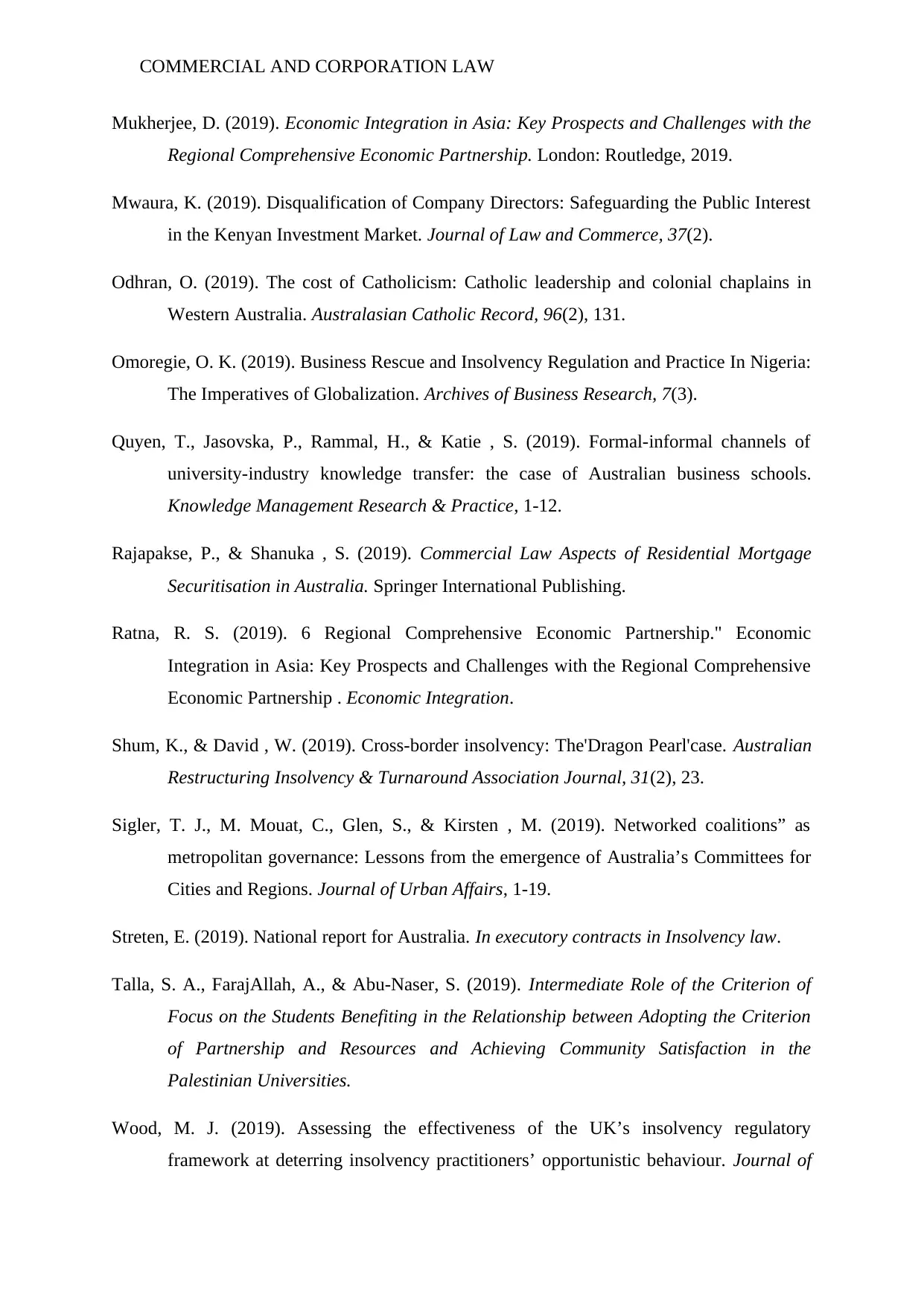
COMMERCIAL AND CORPORATION LAW
Mukherjee, D. (2019). Economic Integration in Asia: Key Prospects and Challenges with the
Regional Comprehensive Economic Partnership. London: Routledge, 2019.
Mwaura, K. (2019). Disqualification of Company Directors: Safeguarding the Public Interest
in the Kenyan Investment Market. Journal of Law and Commerce, 37(2).
Odhran, O. (2019). The cost of Catholicism: Catholic leadership and colonial chaplains in
Western Australia. Australasian Catholic Record, 96(2), 131.
Omoregie, O. K. (2019). Business Rescue and Insolvency Regulation and Practice In Nigeria:
The Imperatives of Globalization. Archives of Business Research, 7(3).
Quyen, T., Jasovska, P., Rammal, H., & Katie , S. (2019). Formal-informal channels of
university-industry knowledge transfer: the case of Australian business schools.
Knowledge Management Research & Practice, 1-12.
Rajapakse, P., & Shanuka , S. (2019). Commercial Law Aspects of Residential Mortgage
Securitisation in Australia. Springer International Publishing.
Ratna, R. S. (2019). 6 Regional Comprehensive Economic Partnership." Economic
Integration in Asia: Key Prospects and Challenges with the Regional Comprehensive
Economic Partnership . Economic Integration.
Shum, K., & David , W. (2019). Cross-border insolvency: The'Dragon Pearl'case. Australian
Restructuring Insolvency & Turnaround Association Journal, 31(2), 23.
Sigler, T. J., M. Mouat, C., Glen, S., & Kirsten , M. (2019). Networked coalitions” as
metropolitan governance: Lessons from the emergence of Australia’s Committees for
Cities and Regions. Journal of Urban Affairs, 1-19.
Streten, E. (2019). National report for Australia. In executory contracts in Insolvency law.
Talla, S. A., FarajAllah, A., & Abu-Naser, S. (2019). Intermediate Role of the Criterion of
Focus on the Students Benefiting in the Relationship between Adopting the Criterion
of Partnership and Resources and Achieving Community Satisfaction in the
Palestinian Universities.
Wood, M. J. (2019). Assessing the effectiveness of the UK’s insolvency regulatory
framework at deterring insolvency practitioners’ opportunistic behaviour. Journal of
Mukherjee, D. (2019). Economic Integration in Asia: Key Prospects and Challenges with the
Regional Comprehensive Economic Partnership. London: Routledge, 2019.
Mwaura, K. (2019). Disqualification of Company Directors: Safeguarding the Public Interest
in the Kenyan Investment Market. Journal of Law and Commerce, 37(2).
Odhran, O. (2019). The cost of Catholicism: Catholic leadership and colonial chaplains in
Western Australia. Australasian Catholic Record, 96(2), 131.
Omoregie, O. K. (2019). Business Rescue and Insolvency Regulation and Practice In Nigeria:
The Imperatives of Globalization. Archives of Business Research, 7(3).
Quyen, T., Jasovska, P., Rammal, H., & Katie , S. (2019). Formal-informal channels of
university-industry knowledge transfer: the case of Australian business schools.
Knowledge Management Research & Practice, 1-12.
Rajapakse, P., & Shanuka , S. (2019). Commercial Law Aspects of Residential Mortgage
Securitisation in Australia. Springer International Publishing.
Ratna, R. S. (2019). 6 Regional Comprehensive Economic Partnership." Economic
Integration in Asia: Key Prospects and Challenges with the Regional Comprehensive
Economic Partnership . Economic Integration.
Shum, K., & David , W. (2019). Cross-border insolvency: The'Dragon Pearl'case. Australian
Restructuring Insolvency & Turnaround Association Journal, 31(2), 23.
Sigler, T. J., M. Mouat, C., Glen, S., & Kirsten , M. (2019). Networked coalitions” as
metropolitan governance: Lessons from the emergence of Australia’s Committees for
Cities and Regions. Journal of Urban Affairs, 1-19.
Streten, E. (2019). National report for Australia. In executory contracts in Insolvency law.
Talla, S. A., FarajAllah, A., & Abu-Naser, S. (2019). Intermediate Role of the Criterion of
Focus on the Students Benefiting in the Relationship between Adopting the Criterion
of Partnership and Resources and Achieving Community Satisfaction in the
Palestinian Universities.
Wood, M. J. (2019). Assessing the effectiveness of the UK’s insolvency regulatory
framework at deterring insolvency practitioners’ opportunistic behaviour. Journal of

COMMERCIAL AND CORPORATION LAW
Corporate Law Studies , 1-34.
Corporate Law Studies , 1-34.
⊘ This is a preview!⊘
Do you want full access?
Subscribe today to unlock all pages.

Trusted by 1+ million students worldwide
1 out of 12
Related Documents
Your All-in-One AI-Powered Toolkit for Academic Success.
+13062052269
info@desklib.com
Available 24*7 on WhatsApp / Email
![[object Object]](/_next/static/media/star-bottom.7253800d.svg)
Unlock your academic potential
Copyright © 2020–2025 A2Z Services. All Rights Reserved. Developed and managed by ZUCOL.





